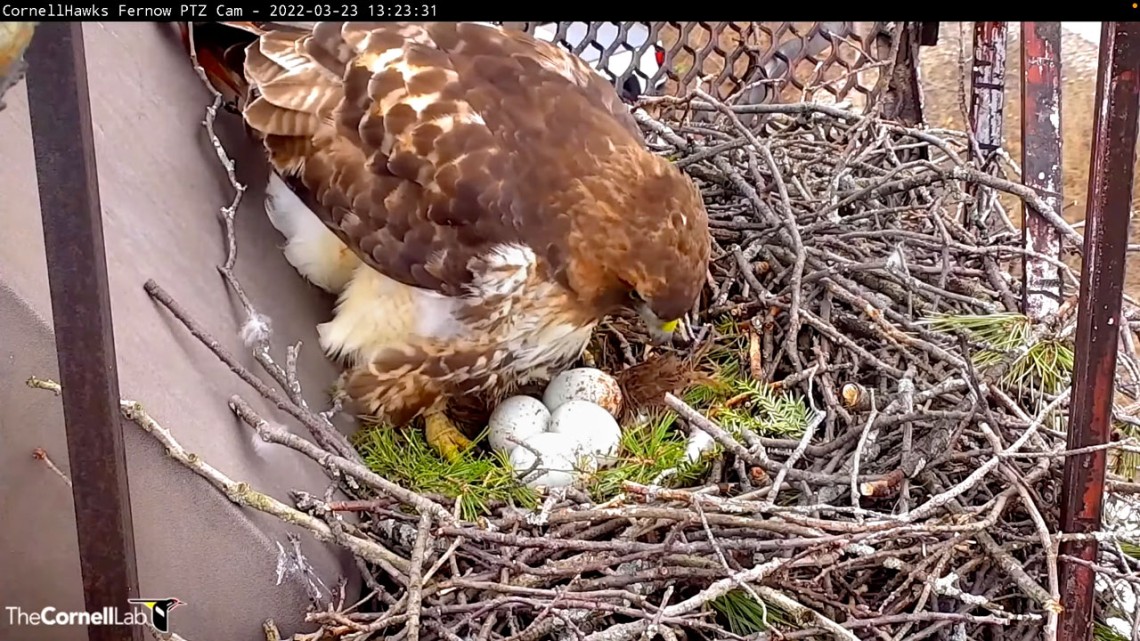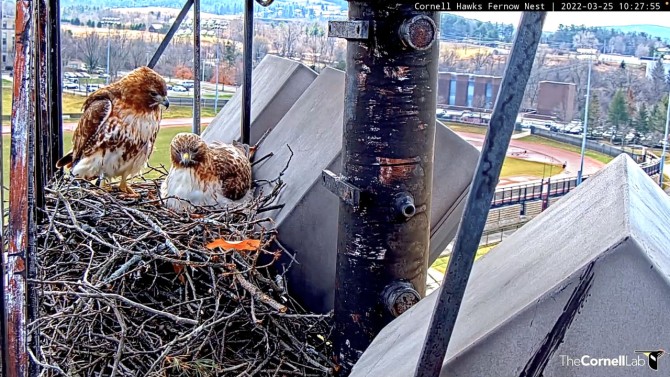
Big Red at the nest, with her four eggs.
A first: Cornell’s red-tailed hawk lays fourth egg
By Pat Leonard
There’ll be 33% more excitement in the hawk’s nest along Cornell’s Tower Road this spring.
For the first time since the Lab of Ornithology installed a live camera on the nest in 2012, Big Red, the female red-tailed hawk, has produced a fourth egg. It’s a big deal because in the 10 previous breeding seasons captured by the live camera, Big Red has laid three eggs each season.
“The fourth egg really caught us all by surprise,” said Charles Eldermire, leader of the Bird Cams project. “It’s exciting to think that there’s so much more to learn from our longest-running live camera.”
Surprise and delight are also reflected in the flood of comments from cam-watchers. Many take note of what at a busy spring it will be for Big Red and her mate, Arthur, named for Arthur A. Allen, Cornell professor and Lab of Ornithology founder.
Some of the online comments:
“Congrats, Cornell! The skies around campus will be busy this spring/summer. They’re going to need a bigger nest!”
“OMG!!! I’m speechless! Been watching for many years and this is a first. Stay healthy and strong, beautiful family!”
“Wow, Amazing! Congratulations Big Red and Arthur and Cornell. I started watching last season and thought it was a busy nest. Both parents are going to be very, very busy this year! I’m so excited and proud to be watching again.”
Big Red and Arthur, who are nesting above the university athletic fields, have made use of two different light towers across breeding seasons, switching off from one nearest Weill Hall to another near Fernow Hall, where they are now. Typically, red-tailed hawks place their nests in the crowns of tall trees or on cliffs, so they can see the lay of the land and hunt small mammals. The Cornell light poles are clearly a very acceptable substitute.
Right now, Big Red is spending most of her time incubating the clutch of eggs, with occasional assistance from Arthur. “Pipping” comes next – that’s when you see a hole in the egg, created as the chick inside begins to peck its way out. The first egg is expected to hatch in late April.
If all the eggs hatch, camera watchers will see a lot of white, fuzzy, voracious “bobble-heads” in the nest waiting for mom and dad’s meal delivery – anything from other birds to chipmunks or even a snake.
Join hawk watchers from more than 150 countries to watch the family drama unfold. And the infrared camera makes it possible to check in day or night.
Pat Leonard is a staff writer for the Cornell Lab of Ornithology.
Get Cornell news delivered right to your inbox.
Subscribe

